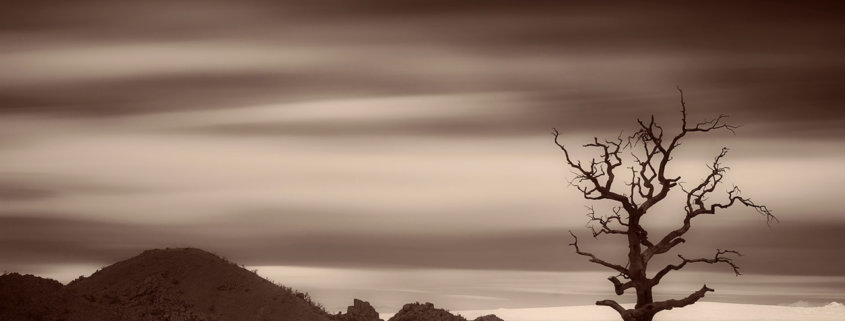How to Develop Your Personal Photographic Style
Developing a unique photographic style is a goal of every photographer. It is an evolutionary process that takes time and experience. Once it begins to develop within your images, it is an exciting and fulfilling feeling. It may change and grow over time but oftentimes there is a baseline style or thread that weaves throughout most of your images. There is no requirement for you to stick with one style for every image and it is possible to have different styles that may or may not change over time.

Infrared, minimalistic images combined with long exposures and processed as sepia toned is one of my trademark personal styles.
What Exactly is a Photographic Style?
Photographic style is the look or feeling that your images project. It is not based only on technique but rather on your emotional response to the subject. It can reflect your deeper thoughts or mood. It can be based on interests you have in your life. But in the end, it becomes your trademark.
Developing Your Style
When I was in art school, we had a class on personal style. To help us develop it, we had to answer a number of questions:
- When you first started out in photography, why did you take photographs?
- What message are you trying to convey?
- What subjects are you most drawn to?
Once you answer those questions, find three photographers whose work you admire. What is it about their work that you are drawn to? Is the work colorful or not? Busy or minimalistic? Vibrant or subdued? Motion or stillness? Realistic or surreal? How do the photos make you feel? What camera techniques do they utilize that you are drawn to? What do they do in post processing (or traditional darkroom techniques) that interest you?
Once you have answered these questions, look for adjectives that describe their work; then see if these adjectives relate to your work. In my portfolio of landscape images, these are some of the words that describe much of my work:
- Minimalistic
- Dramatic skies
- Simple compositions
- Sense of solitary strength

Simplistic compositions with low horizon lines allows me to capture the power and movement of the clouds.
With your adjectives, you can then start seeing the beginning of your style. If you shoot many different subjects, see if there is a thread that links them.
Once you have adjectives for your images, the following can also make up your style:
- Subject matter
- Color or tonal range
- Shooting angle (or preferred lens choice)
- The type of light you capture
- In-camera techniques
- Post-processing style

Even when my subject matter changes, there is still an underlying baseline personal style. Infrared, similar post-processing, solitary subjects, sense of rural spaces, sepia tone and putting a greater importance on dramatic skies do tend to exist in many of my portfolio images.
A Final Note
Being inspired by other photographers or admiring their work is fine, but don’t try to emulate it. My love of Ansel Adams ignited my passion for photography; but it was not until later that I realized that my love of black and white came first… which drew me to the works of Ansel Adams. Find your own way to break away from those you admire to create your own style. It is your style that sets you apart from everyone else.




